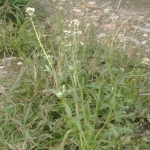| Common Name: |
Lady's Purse |
| Other Names: |
Blindweed, Chinese Cress, Cocowort, Mother's Heart, nazuna, Pepper-and-Salt, Pickpocket, Shepherd's Heart, Shepherd's Purse, St. James' Weed, Witch's Pouch. |
| Botanical Name: |
Capsella bursa-pastoris syn. Thlapsi bursa-pastoris |
| Genus: |
Capsella |
| Family: |
Brassicaceae |
| Native Location: |
Temperate and warm regions worldwide |
| Cultivation: |
Well-drained soil in sun or partial shade. Tolerates poor conditions. |
| Propagation: |
By seed sown in spring. It self-seeds freely. |
| Harvest: |
Whole plants are cut from late spring to autumn and used fresh, or dried in bunches for infusions, decoctions, or liquid extracts. Leaves and seed pods are gathered as required for culinary use. |
| Height: |
3-40cm (1¼-16in) |
| Width: |
3-15in (1¼-6in) |
| Hardiness: |
Z3-9 |
| History: |
We know that shepherd's purse was used by the ancient Romans—its name is derived from the Latin capsella, meaning "purse", because the plant's seed pouches resembled the "purses" that old-time shepherds hung from their belts. But the plant's use as a food and medicine in fact predates recorded history. Archaeologists clearing the excavation site at Catal Huyuk found seeds from the plant in the 8,000-year-old ruins. |
| Parts Used: |
Whole plant (ji cai), leaves, seed pods, Aerial Parts |
| Properties: |
An astringent, diuretic herb that also acts as a urinary antiseptic and blood coagulant. |
| Medicinal Uses: |
Internally and externally to stop bleeding, especially in heavy menstruation, blood in urine, hemorrhoids, nosebleed, and wounds. Also internally for cystitis, and externally for vericose veins. In Chinese medicine, to cool the blood, with uses similar to the above; also for hypertension and postpartum bleeding.
To treat nosebleed, menstrual difficulties, headache, and bladder inflammation. Germany's Commission E has approved the use of shepherd's purse to treat wounds, burns, premenstrual syndrome (PMS), and nosebleed.
Shepherd's purse has antiseptic, astringent, blood-coagulating, diuretic, and vasoconstricting properties. Most herbalists use shepherd's purse to treat almost any kind of heavy bleeding, including that associated with nosebleeds, hemorrhoids, injuries, menopause, menstruation, and the postpartum period. The herb is also used to treat cystitis (a common bladder infection). The plant's young leaves, which may be added to salads, are rich in vitamins A, B, C, and K (the vitamin essential for blood clotting). |
| Preparation: |
Shepherd's purse is available as dried herb and in teas and tinctures. To make a tea, pour 1 cup of boiling water over 1 teaspoon of dried herb and steep for 5 minutes. Strain, and drink tea warm, 3 tablespoons at a time, up to 3 cups daily. |
| Typical Dose: |
A typical daily dose of shepherd's purse may range from 10 to 15 gm of the herb. |
| Caution: |
Shepherd's purse constricts blood vessels, which can raise blood pressure. It also stimulates blood clotting. If you have hypertension or a blood-clotting disorder, and/or you are taking blood pressure medication or anticoagulants, avoid using shepherd's purse and consult your medical practitioner instead. |
| Possible Side Effects: |
Shepherd's purse's side effects include abnormal thyroid function, abnormal menstruation, and elevated or lowered blood pressure. |
| Drug Interactions: |
| Taking shepherd's purse with these drugs may be harmful: |
| Digitalis, (Digitek, Lanoxin)—May increase the risk of excessively low blood pressure, irregular heartbeat, and slow heartbeat. |
Levothyroxine, (Levothroid, Synthroid)—May interfere with the action of the drug. |
|
| Disease Effects: |
May interfere with therapy for thyroid or heart conditions. |
| Culinary Uses: |
Leaves are rich in vitamins A, B, and C, and may be added to salads or cooked as a vegetable. Seed pods have a peppery flavor and may be used as seasoning. |
| Bibliography: |
Encylopedia of Herbs by Deni Brown Copyright ©: 1995, 2001 Dorling Kindersley Limited pg 153
The Essential Herb-Drug-Vitamin Interaction Guide by Geo. T. Grossberg,MD and Barry Fox,PhD Copyright©2007 Barry Fox,PhD. Pp.422-423
The Modern Herbal Primer by Nancy Burke Copyright©2000 Yankee Publishing, Inc. pg. 38 |

